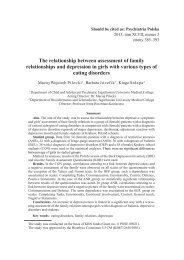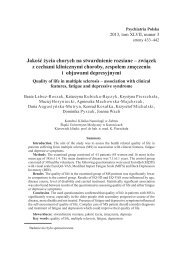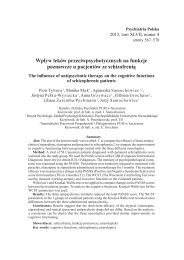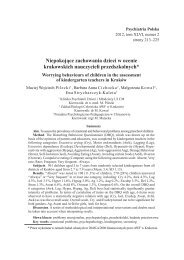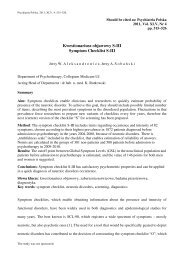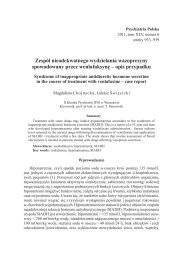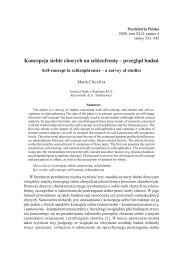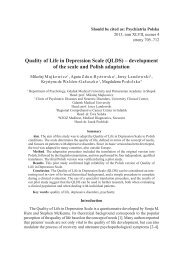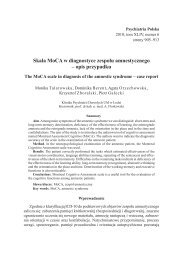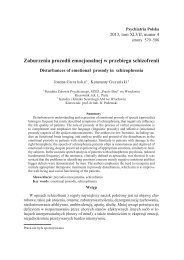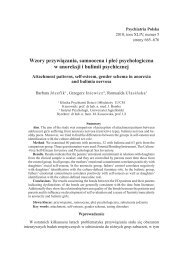Polish adaptation and validation of the Agoraphobic Cognitions ...
Polish adaptation and validation of the Agoraphobic Cognitions ...
Polish adaptation and validation of the Agoraphobic Cognitions ...
You also want an ePaper? Increase the reach of your titles
YUMPU automatically turns print PDFs into web optimized ePapers that Google loves.
680Jarosław M. Michałowski, Paweł Holasresults in <strong>the</strong> development <strong>of</strong> panic. Cognitive models do not, however, explain <strong>the</strong>origin <strong>of</strong> panic attacks in situations where catastrophic misinterpretations <strong>of</strong> somaticsymptoms cannot be identified, e.g., at night [3]. Among <strong>the</strong> concepts attempting toexplain such phenomena is a symptom progression model <strong>of</strong> panic based on a learning<strong>the</strong>ory perspective proposing that somatic symptoms associated with <strong>the</strong> initial panicattack turn into threat cues <strong>and</strong> become conditioned elicitors <strong>of</strong> anxious apprehension.[4,5]. As a result <strong>of</strong> that mechanism, even slight symptoms <strong>of</strong> fear or arousal become<strong>the</strong> conditioned stimulus associated with an intense fear or strong arousal (so-calledinteroceptive threat signal), <strong>and</strong> begin to evoke a conditioned fear response. Theauthors <strong>of</strong> this approach state that <strong>the</strong> interoceptive conditioning process may occureven without <strong>the</strong> participation <strong>of</strong> consciousness [6,7,8]. On <strong>the</strong> basis <strong>of</strong> <strong>the</strong> interoceptiveconditioning concept, Goldstein <strong>and</strong> Chambless [9] presented a coherent modelexplaining <strong>the</strong> occurrence <strong>and</strong> persistence <strong>of</strong> agoraphobia <strong>and</strong> panic disorder, <strong>and</strong>suggested that <strong>the</strong> reaction acquired as a result <strong>of</strong> interoceptive conditioning be called<strong>the</strong> fear <strong>of</strong> fear. On <strong>the</strong> basis <strong>of</strong> a three-level fear model presented by Lang in 1985[10], <strong>the</strong> authors separated three components <strong>of</strong> <strong>the</strong> fear <strong>of</strong> fear: emotional, cognitive<strong>and</strong> behavioral. On <strong>the</strong> emotional level, an increased fear <strong>of</strong> fear is associated with<strong>the</strong> appearance <strong>of</strong> an exaggerated fear response to interoceptive signals (e.g., heartpalpitations). Those signals may appear as a result <strong>of</strong> heavy or long-term stress aswell as various emotional states (such as joy or anger), environmental conditions (e.g.,high temperature) or substances altering <strong>the</strong> physiological activity <strong>of</strong> <strong>the</strong> organism(e.g., c<strong>of</strong>fee). On <strong>the</strong> cognitive level, people with high fear <strong>of</strong> fear develop automaticthoughts <strong>of</strong> negative medical <strong>and</strong> social consequences <strong>of</strong> physiological arousal (e.g.,„I’m going to have a heart attack”). Associating interoceptive signals with threat maylead to <strong>the</strong> development <strong>of</strong> avoidance behaviors typical for agoraphobia (behaviorallevel), whose aim is to avoid situations <strong>of</strong> higher risk <strong>of</strong> experiencing <strong>the</strong> symptoms<strong>and</strong>/or decreased availability <strong>of</strong> help. Chambless <strong>and</strong> coworkers [11,12] developedthree questionnaires for assessing <strong>the</strong> above-mentioned components <strong>of</strong> <strong>the</strong> fear <strong>of</strong> fear:Body Sensations Questionnaire (BSQ; suggested <strong>Polish</strong> version name: KwestionariuszDoznań Cielesnych, [KDC]), measuring <strong>the</strong> intensity <strong>of</strong> fear response to interoceptivesignals, <strong>Agoraphobic</strong> <strong>Cognitions</strong> Questionnaire (ACQ; suggested <strong>Polish</strong> version name:Kwestionariusz Myśli Towarzyszących Agorafobii, [KMTA]), testing for <strong>the</strong> presence<strong>of</strong> automatic thoughts about negative medical <strong>and</strong> social consequences <strong>of</strong> fear <strong>and</strong> <strong>of</strong>those signals [11], <strong>and</strong> Mobility Inventory (MI; <strong>Polish</strong> version name: Skala ZachowańUnikowych Towarzyszących Agorafobii, [SZUTA]), measuring <strong>the</strong> intensity <strong>of</strong>avoidance [12,13]. In this article we will present <strong>the</strong> results <strong>of</strong> tests conducted on <strong>the</strong>basis <strong>of</strong> <strong>the</strong> <strong>Polish</strong> ACQ <strong>and</strong> BSQ translations in a group <strong>of</strong> agoraphobic patients <strong>and</strong>in a control group.Factor analysis <strong>of</strong> <strong>the</strong> original ACQ version on <strong>the</strong> basis <strong>of</strong> <strong>the</strong> answers given by 88agoraphobic patients showed an existence <strong>of</strong> two slightly correlated factors (r = 0.26)explaining 46.6% <strong>of</strong> <strong>the</strong> total variance [11]. As a result, two subscales were separated:one measuring concerns regarding medical consequences <strong>of</strong> fear (Physical concernssubscale), <strong>and</strong> one measuring concerns regarding social <strong>and</strong> behavioral consequences<strong>of</strong> control loss (Social/behavioral concerns subscale). Cronbach’s alpha coefficients for
<strong>Polish</strong> <strong>adaptation</strong> <strong>of</strong> <strong>the</strong> <strong>Agoraphobic</strong> <strong>Cognitions</strong> Questionnaire<strong>and</strong> <strong>the</strong> Body Sensations Questionnaire681<strong>the</strong> items included in <strong>the</strong> first subscale amounted to 0.65, <strong>and</strong> for <strong>the</strong> o<strong>the</strong>r subscale to0.76. The two-factor ACQ structure was confirmed in fur<strong>the</strong>r research [14, 15, 16]. Upto <strong>the</strong> present, <strong>the</strong> research has shown a satisfactory reliability <strong>of</strong> <strong>the</strong> ACQ measuredwith <strong>the</strong> test-retest method (≤ 31 days; rs = 0.75 – 0.86).As to <strong>the</strong> BSQ, <strong>the</strong> previous study investigating agoraphobics <strong>and</strong> controls showedits high internal consistency (Cronbach’s alpha = 0.87) <strong>and</strong> moderately satisfactoryreliability (r = 0.66) tested by <strong>the</strong> test-retest method (≤ 31 days [11]). These BSQcharacteristics have been confirmed on German population [15]. Moreover, severalprevious studies confirmed a high construct validity <strong>of</strong> both questionnaires, showingthat <strong>the</strong> scores <strong>of</strong> <strong>the</strong> BSQ <strong>and</strong> <strong>the</strong> ACQ as well as <strong>of</strong> both ACQ subscales satisfactorilydifferentiate patients suffering from agoraphobia/panic disorder from control subjects[15, 16], <strong>and</strong> effective psycho<strong>the</strong>rapy results in significant scores reduction in bothquestionnaires [11, 15]. Previous research also showed [11, 15] that both questionnairesare highly correlated with <strong>the</strong> scores <strong>of</strong> <strong>the</strong> o<strong>the</strong>r scales measuring <strong>the</strong> features <strong>of</strong>patients with agoraphobia <strong>and</strong>/or panic attacks (e.g. Mobility Inventory [12, 13], FearQuestionnaire [17]) <strong>and</strong> moderately correlated with <strong>the</strong> scales measuring trait anxiety(State-Trait Anxiety Inventory X2 [18,19]), depression (Beck Depression Inventory[20]) <strong>and</strong> neuroticism (Eysenck Personality Questionnaire [21,22]).MaterialA total <strong>of</strong> 182 people were tested: 82 out- <strong>and</strong> inpatients diagnosed as agoraphobic,<strong>and</strong> 100 controls without diagnosed mental disorders.Patients were diagnosed by experienced clinicians according to <strong>the</strong> DSM-IV criteria[23]. The questionnaires were filled before <strong>the</strong> beginning <strong>of</strong> psycho<strong>the</strong>rapy. Thecontrol <strong>and</strong> clinical groups were not differentiated in terms <strong>of</strong> age <strong>and</strong> sex. (t’s (180)< 2, p’s > 0.05).MethodsThe aim <strong>of</strong> <strong>the</strong> present research was to determine <strong>the</strong> factor structure as well asvalidity <strong>and</strong> reliability <strong>of</strong> <strong>the</strong> <strong>Polish</strong> versions <strong>of</strong> <strong>the</strong> ACQ <strong>and</strong> <strong>the</strong> BSQ. The questionnaireshad been translated <strong>and</strong> <strong>the</strong> translations had been consulted with <strong>the</strong> author, D.L.Chambless [24], according to <strong>the</strong> procedure <strong>of</strong> back-translation. Besides <strong>the</strong> ACQ <strong>and</strong><strong>the</strong> BSQ <strong>the</strong> research included <strong>the</strong> following set <strong>of</strong> questionnaires:• Mobility Inventory (MI) [12] is designed for measuring <strong>the</strong> tendency to avoid26/27 different situations on a 5-point scale (I never avoid (1), I always avoid(5)). For each situation <strong>the</strong> avoiding tendencies intensity is tested twice – in <strong>the</strong>case where <strong>the</strong> confrontation with it takes place in solitude (subscale „AvoidanceWhen Alone”) <strong>and</strong> in <strong>the</strong> case where <strong>the</strong> confrontation takes place in company <strong>of</strong>o<strong>the</strong>r people (subscale „Avoidance When Accompanied”). The <strong>Polish</strong> version <strong>of</strong><strong>the</strong> questionnaire prepared by Michalowski <strong>and</strong> coworkers [13] was used.• Eysenck Personality Questionnaire – Revised (EPQ-R) [21] is a self-report personalityquestionnaire consisting <strong>of</strong> a 100 questions that have been assigned to four
682Jarosław M. Michałowski, Paweł Holassubscales: Neurotisicm, Extroversion, Psychoticism <strong>and</strong> Lie. The <strong>Polish</strong> version<strong>of</strong> <strong>the</strong> questionnaire prepared by Brzozowski <strong>and</strong> Drwal [22] was used.• The Anxiety Sensitivity Index - III (ASI-3) [25] is a self-assessment questionnairedesigned for measuring <strong>the</strong> intensity <strong>of</strong> 18 different symptoms <strong>of</strong> <strong>the</strong> fear <strong>of</strong> fear<strong>and</strong> <strong>of</strong> arousal. It consists <strong>of</strong> 3 subscales: fear related to organism <strong>and</strong> health, fearrelated to mental processes <strong>and</strong> fear related to being among people. In <strong>the</strong> presentstudy, <strong>the</strong> <strong>Polish</strong> version <strong>of</strong> <strong>the</strong> questionnaire prepared by Michalowski <strong>and</strong> coworkers[26] was used.• State-Trait Anxiety Inventory (STAI-X2) [18,19] is designed for <strong>the</strong> self-assessment<strong>of</strong> general anxiety level.• Beck Depression Inventory (BDI) [20] is designed for <strong>the</strong> self-assessment <strong>of</strong> depressionsymptoms intensity.ResultsFactor structureThe factor structure <strong>of</strong> <strong>the</strong> ACQ was analyzed on <strong>the</strong> basis <strong>of</strong> <strong>the</strong> data received fromagoraphobics (n = 82). Exploratory Factor Analysis showed <strong>the</strong> existence <strong>of</strong> 5 factorswith eigenvalues higher than 1. Thorough analysis confirmed that <strong>the</strong> two-factor modelproposed by <strong>the</strong> authors <strong>of</strong> <strong>the</strong> original [11] best reflects <strong>the</strong> data structure: two main factorswith eigenvalues 4.07 <strong>and</strong> 2.43 explained 46.4% <strong>of</strong> <strong>the</strong> variance, while <strong>the</strong> remainingfactors had eigenvalues < 1.2 <strong>and</strong> explained up to 8% <strong>of</strong> <strong>the</strong> variance. Items loadingsanalyzed after a Promax rotation are presented in Table 1. Two test items (nos. 1 <strong>and</strong>5) showed low correlations with both proposed factors (≤ 0.40). In order to check <strong>the</strong>accuracy <strong>of</strong> <strong>the</strong> proposed two-factor model, confirmatory factor analysis applying <strong>the</strong>AMOS 18 program was conducted with <strong>the</strong> use <strong>of</strong> <strong>the</strong> maximum likelihood estimation[27]. The analysis showed acceptable fit <strong>of</strong> <strong>the</strong> two-factor solution, where one factorcontains items reflecting concerns <strong>of</strong> social <strong>and</strong> behavioral consequences <strong>of</strong> controlloss, i.e., 6, 8, 9, 11, 12, 13, 14, <strong>and</strong> <strong>the</strong> o<strong>the</strong>r items reflecting concerns <strong>of</strong> medicalconsequences <strong>of</strong> fear, i.e., 2, 3, 4, 7, 10 (χ2 = 71.9, df = 53 (p = 0.43), GFI = 0.875,AGFI = 0.816, RMSEA = 0.066 (p = 0.242), CFI = 0.937). For all <strong>the</strong> above-mentioneditems <strong>the</strong> st<strong>and</strong>ardized regression coefficients were higher than 0.30.Table 1. Factor structure <strong>of</strong> <strong>the</strong> ACQ for <strong>Agoraphobic</strong> Sample (n=82): individual item factorloadings, eigenvalues <strong>and</strong> explained variance for <strong>the</strong> two selected factorsItem content social/behavioral subscale physical subscaleThrow up 0.17 0.23Pass out - 0.01 0.63Have a brain tumor 0.02 0.78Have a heart attack 0.30 0.78Choke to death 0.40 0.39Act foolishly 0.74 0.25table continued on next page
<strong>Polish</strong> <strong>adaptation</strong> <strong>of</strong> <strong>the</strong> <strong>Agoraphobic</strong> <strong>Cognitions</strong> Questionnaire<strong>and</strong> <strong>the</strong> Body Sensations Questionnaire683Go blind 0.19 0.54Lose control 0.84 0.04Hurt someone 0.41 0.15Have a stroke 0.20 0.85Go crazy 0.71 0.16Scream. 0.66 0.08Babble or talk `funny` 0.78 0.06Paralyzed by fear 0.68 0.24Eigenvalue 4.07 2.42Explained variance % 29.1 17.3ReliabilityStatistical analyses confirmed a high internal consistency <strong>of</strong> <strong>the</strong> ACQ (Cronbach alpha= 0.78 in <strong>the</strong> control group (n = 100), <strong>and</strong> 0.80 in agoraphobics (n = 82, see Table 2)),<strong>and</strong> <strong>the</strong> test-retest reliability (28 days; r = 0.88 in <strong>the</strong> control group (n = 46)). Item-totalcorrelations calculated for <strong>the</strong> <strong>Polish</strong> version <strong>of</strong> <strong>the</strong> ACQ ranged from 0.33 to 0.66.Table 2. Mean, st<strong>and</strong>ard deviation, item-total correlations <strong>and</strong> test-retest reliabilitycoefficients for each individual item <strong>of</strong> <strong>the</strong> <strong>Agoraphobic</strong> <strong>Cognitions</strong> Questionnairein normal controls <strong>and</strong> agoraphobicsItem content** p
684Jarosław M. Michałowski, Paweł HolasAs to <strong>the</strong> BSQ, our analyses confirmed its high internal consistency (Cronbach alpha= 0.94 in <strong>the</strong> control group (n = 100) <strong>and</strong> 0.88 in agoraphobics (n = 70), see Tab. 3),as well as moderately satisfactory test-retest reliability that was tested in <strong>the</strong> controlgroup (r = 0.69; test-retest 28 days; n = 46). Moreover, <strong>the</strong> present study indicates highitem-total correlations <strong>of</strong> all single BSQ items (0.48–0.80).Table 3. Mean, st<strong>and</strong>ard deviation, item-total correlations <strong>and</strong> test-retest reliabilitycoefficients for each individual item <strong>of</strong> <strong>the</strong> Body Sensations Questionnairein normal controls <strong>and</strong> agoraphobicsItem contentNormal ControlsItem-total correlationsTest-retestM SD r r<strong>Agoraphobic</strong>sItem-total correlationsM SD rHeart palpitations 2.00 0.95 0.66 ** 0.48 ** 3.64 1.18 0.56 **Pressure/Heavy feeling in chest 2.09 1.01 0.70 ** 0.53 ** 3.53 1.28 0.56 **Numbness in arms or legs 1.86 1.03 0.73 ** 0.51 ** 3.21 1.40 0.64 **Tingling in <strong>the</strong> fingertips 1.48 0.86 0.70 ** 0.34 ** 2.30 1.38 0.62 **Numbness in ano<strong>the</strong>r part <strong>of</strong> body 1.77 0.96 0.72 ** 0.46 ** 2.97 1.38 0.54 **Feeling short <strong>of</strong> breath 2.46 1.26 0.69 ** 0.43 ** 3.94 1.25 0.72 **Dizziness 2.22 1.20 0.79 ** 0.56 ** 3.67 1.22 0.61 **Blurred/distorted vision 2.17 1.29 0.76 ** 0.62 ** 3.13 1.36 0.71 **Nausea 1.74 1.04 0.75 ** 0.26 * 2.53 1.33 0.56 **”Butterflies” in stomach 1.52 0.85 0.63 ** 0.44 ** 2.30 1.31 0.48 **Knot in stomach 1.79 0.98 0.62 ** 0.45 ** 2.46 1.46 0.59 **Lump in throat 1.76 1.00 0.70 ** 0.67 ** 2.86 1.33 0.69 **Wobbly/rubber legs 1.91 1.12 0.80 ** 0.47 ** 3.44 1.18 0.63 **Sweating 1.80 0.95 0.60 ** 0.56 ** 2.63 1.37 0.50 **Dry throat 1.56 0.86 0.61 ** 0.47 ** 2.54 1.33 0.58 **Disoriented/confused 2.20 1.23 0.73 ** 0.61 ** 3.71 1.28 0.55 **Disconnected from <strong>the</strong> body 2.00 1.32 0.74 ** 0.62 ** 3.27 1.50 0.58 **** p
<strong>Polish</strong> <strong>adaptation</strong> <strong>of</strong> <strong>the</strong> <strong>Agoraphobic</strong> <strong>Cognitions</strong> Questionnaire<strong>and</strong> <strong>the</strong> Body Sensations Questionnaire685<strong>the</strong> BSQ (r = 0.62, p < 0.001 for <strong>the</strong> patients <strong>and</strong> r = 0.49, p < 0.001 for <strong>the</strong> controlgroup), as well as statistically significant correlations between those scales <strong>and</strong> <strong>the</strong>scores <strong>of</strong> related research tools (r = 0.26 – 0.51 for <strong>the</strong> patients <strong>and</strong> r = 0.36 – 0.67 for<strong>the</strong> control group, see Tab. 4) were also obtained.Table 4. Correlations (Pearson’s r) <strong>of</strong> agoraphobics responses to <strong>the</strong> ACQ<strong>and</strong> BSQ with o<strong>the</strong>r psychometric instrumentsACQ n ASI-3 n MI n STAI X2 n BDI n EPQ-N nACQ 0.67 ** 81 0.36 ** 79 0.51 ** 70 0.49 ** 67 0.53 ** 61BSQ 0.62 ** 78 0.53 ** 77 0.41 ** 77 0.49 ** 66 0.44 ** 64 0.43 ** 61** p
686Jarosław M. Michałowski, Paweł HolasConclusionsThe findings indicate that <strong>Polish</strong>-language versions <strong>of</strong> <strong>the</strong> <strong>Agoraphobic</strong> <strong>Cognitions</strong>Questionnaire (ACQ) <strong>and</strong> <strong>the</strong> Body Sensations Questionnaire (BSQ) meet <strong>the</strong> basicpsychometric criteria. Their high economy, content validity <strong>and</strong> temporal stability make<strong>the</strong>m useful in original <strong>and</strong> replication studies. Moreover, both measures might providea strong support to <strong>the</strong> diagnostic process <strong>and</strong> <strong>the</strong> assessment <strong>of</strong> <strong>the</strong>rapeutic effects,especially as both questionnaires can effectively differentiate between agoraphobic patients,people without agoraphobia <strong>and</strong> patients with o<strong>the</strong>r anxiety disorders [15,16].Acknowledgments: The authors want to express deep gratitude to dr WiesławCubała, dr Karol Karasiewicz, lek. med. Bartłomiej Gorlewski <strong>and</strong> <strong>the</strong> staff <strong>of</strong><strong>the</strong> Neurotic Disorders Unit <strong>of</strong> <strong>the</strong> Psychiatric Hospital in Międzyrzecz for <strong>the</strong>ir helpwith organizing this study.References1. Clark DM. A cognitive approach to panic. Behav Res Ther 1986; 24: 461-470.2. Beck AT, Emery G. Anxiety disorders <strong>and</strong> phobias: A cognitive perspective. New York: BasicBooks; 1985.3. Barlow DH, Brown TA, Craske MG. Definitions <strong>of</strong> panic attacks <strong>and</strong> panic disorder in <strong>the</strong>DSM-IV: Implications for research. J Abnorm Psychol 1994; 103: 553–564.4. Bouton ME, Mineka S, Barlow DH. A modern learning <strong>the</strong>ory perspective on <strong>the</strong> etiology <strong>of</strong>panic disorder. Psychol Rev 2001; 108(1): 4–32.5. Razran G. The observable unconscious <strong>and</strong> <strong>the</strong> inferable conscious in current Soviet psychophysiology:Interoceptive conditioning, semantic conditioning, <strong>and</strong> <strong>the</strong> orienting reflex. Psychophysreview 1961; 68: 81–147.6. Barlow DH. Anxiety <strong>and</strong> its disorders: The nature <strong>and</strong> treatment <strong>of</strong> anxiety <strong>and</strong> panic. NewYork: Guilford Press; 1988.7. LeDoux JE. The emotional brain: The mysterious underpinnings <strong>of</strong> emotional life. New York:Simon & Schuster; 1996.8. Öhman A, Flynkt A, Lyndqvist D. Unconscious emotion: Evolutionary perspectives, psychophysiologicaldata, <strong>and</strong> neuropsychological mechanisms. W: Lane R, Nadel L. red. The cognitiveneuroscience <strong>of</strong> emotion. New York: Oxford Univ Press; 2000. s. 296–327.9. Goldstein AJ, Chambless DL. A reanalysis <strong>of</strong> agoraphobia. Behav Ther 1978; 9: 47–59.10. Lang PJ. The cognitive psychophysiology <strong>of</strong> emotion: Fear <strong>and</strong> anxiety. W: Tuma AH, MaserJD. red. Anxiety & <strong>the</strong> anxiety disorders. Hillsdale, NJ: Erlbaum; 1985. s. 131–179.11. Chambless DL, Caputo GC, Bright P, Gallagher R. Assessment <strong>of</strong> Fear <strong>of</strong> Fear in <strong>Agoraphobic</strong>s:The Body Sensations Questionnaire <strong>and</strong> <strong>the</strong> <strong>Agoraphobic</strong> <strong>Cognitions</strong> Questionnaire. J ConsulClin Psychol 1984; 52(6): 1090–1097.12. Chambless DL, Caputo GC, Jasin SE, Gracely EJ, Williams C. The Mobility Inventory for Agoraphobia.Beh Res Ther 1985; 23: 35–44.13. Michałowski JM, Holas P, Wojdyło K, Gorlewski B. Polska adaptacja i walidacja Skali ZachowańUnikowych Towarzyszących Agorafobii. Psychiatria i Psychoterapia 2013; 2012; 8 (3–4):20–30.14. Arrindell WA. The fear <strong>of</strong> fear concept: evidence in favor <strong>of</strong> multidimensionality. Behav ResTher 1993; 31: 501–518.
<strong>Polish</strong> <strong>adaptation</strong> <strong>of</strong> <strong>the</strong> <strong>Agoraphobic</strong> <strong>Cognitions</strong> Questionnaire<strong>and</strong> <strong>the</strong> Body Sensations Questionnaire68715. Ehlers A, Margraf J, Chambless DL. Fragebogen zu körperbezogenen Ängsten, Kognitionenund Vermeidung, AKV. Weinheim: Beltz Test; 1993.16. Bouvard M, Cottraux J, Talbot F, Duhem S, Yao S, Arthus M, Note I, Cungi C. Validation <strong>of</strong><strong>the</strong> French Translation <strong>of</strong> <strong>the</strong> <strong>Agoraphobic</strong> <strong>Cognitions</strong> Questionnaire. Psycho<strong>the</strong>r Psychosom1998; 67: 249–253.17. Marks IM, Ma<strong>the</strong>ws M. Brief St<strong>and</strong>ard Self Rating for phobic patients. Behav Res Ther 1979;17: 263–267.18. Spielberger C, Gorsuch A, Lushene R. The State-Trait Anxiety Inventory. Palo Alto, CA: ConsultingPsychologists Press; 1970.19. Wrześniewski K, Sosnowski T, Matusik D. Inwentarz Stanu i Cechy Lęku STAI. Polska adaptacjaSTAI. Podręcznik. Warszawa: PTP; 2002.20. Beck AT, Ward CH, Mendelsohn M, Mock J, Erbaugh J. An inventory for measuring depression.Arch Gen Psychiatry 1961; 4: 561–571.21. Eysenck HJ, Eysenck SGB. Eysenck Personality Questionnaire. San Diego, Ca: Educational<strong>and</strong> Industrial Testing Service; 1975.22. Brzozowski P, Drwal RŁ. Kwestionariurz Osobowości Eysencka. Polska adaptacja EPQ-R.Podręcznik. Warszawa: Pracownia Testów Psychologicznych PTP; 1995.23. Wciórka J. ed. Kryteria diagnostyczne według DSM-IV. Wyd. Elsevier; 200824. Chambless DL, Gracely EJ. Fear <strong>of</strong> fear <strong>and</strong> <strong>the</strong> anxiety disorders. Cog Ther Res 1989; 13:9–20.25. Taylor S, Zvolensky MJ, Cox BJ, Deacon B, Heimberg RG, et al. Robust Dimensions <strong>of</strong> AnxietySensitivity: Development <strong>and</strong> Initial Validation <strong>of</strong> <strong>the</strong> Anxiety Sensitivity Index – 3. PsycholAssessment 2007; 19(2): 176–188.26. Michałowski JM, Holas P, Zvolensky MZ. <strong>Polish</strong> <strong>adaptation</strong> <strong>and</strong> <strong>validation</strong> <strong>of</strong> Anxiety SensitivityInventory-III; submitted.27. Arbuckle JL. AMOS (Version 18.0). Chicago, IL: SPSS Inc.; 2009.Correspondence address:Dr Jarosław MichałowskiFaculty <strong>of</strong> Psychology, University <strong>of</strong> Warsaw,Stawki Street 5/7, 00-183 Warszawaemail: jmichalowski@psych.uw.edu.pl



